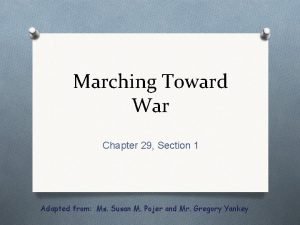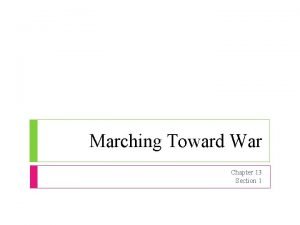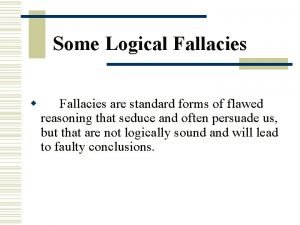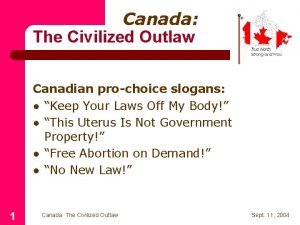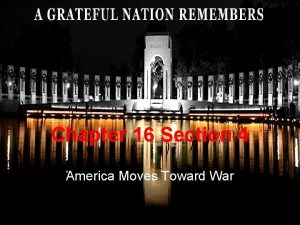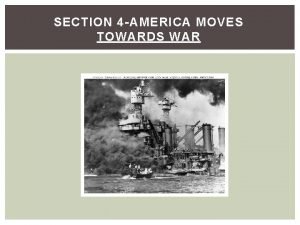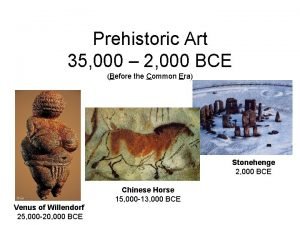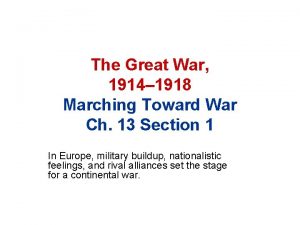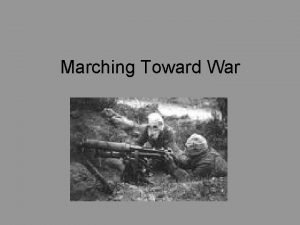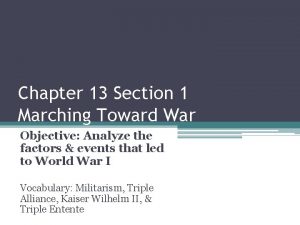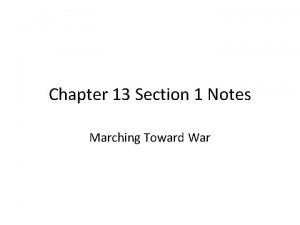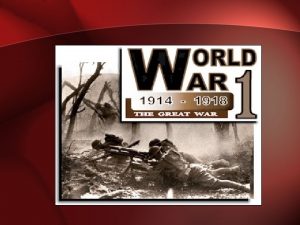Marching Toward War Introduction Efforts to outlaw war






















- Slides: 22

Marching Toward War

Introduction Efforts to outlaw war and achieve a permanent peace had been gaining momentum in Europe since the middle of the 19 th century. u Some Europeans believed that progress had made war a thing of the past. u Yet in little more than a decade, a massive war would spread across the globe. u

Rising Tensions in Europe u Below the surface of peace and goodwill, Europe witnessed several gradual developments that would ultimately help propel the continent into war.

The Rise of Nationalism The growth of nationalism—deep devotion to one’s nation—caused intense competition among the Great Powers: Germany, Austria-Hungary, Great Britain, Russia, Italy, and France. u The Great Powers competed for markets and territory. u Intense nationalism in the nations of the Balkans led to demands for independence among Serbs, Bulgarians, Romanians, and others. u

Imperialism and Militarism Imperialism, and the quest for colonies sometimes pushed European nations to the brink of war and intensified the sense of rivalry and mistrust. u The nations of Europe took pride in having strong militaries and being prepared for war. This led to a dangerous arms race. u Glorifying military power is called militarism. u

Tangled Alliances u Growing rivalries and mutual mistrust had led to the creation of several military alliances among the Great Powers as early as the 1870 s. This alliance system had been designed to keep peace in Europe. But it would instead help push the continent into war.

Bismarck Forges Early Pacts Between 1864 and 1871, Prussia’s bloodand-iron chancellor, Otto von Bismarck, freely used war to unify Germany. u Bismarck saw France as the greatest threat to peace. u His goal was to isolate France and leave it without allies. u In 1879, Bismarck formed the Dual Alliance between Germany and Austria. Hungary. u In 1881, Italy joined this alliance forming the Triple Alliance. u

Triple Alliance (1881)

Shifting Alliances Threaten Peace In 1890, Germany’s foreign policy changed dramatically. That year, Kaiser Wilhelm II—ruler of Germany—forced Bismarck to resign. u Wilhelm let his nation’s treaty with Russia lapse in 1890. u Russia formed a military alliance with France in 1892 and 1894. Such an alliance had been Bismarck’s fear. u

u Picture of Kaiser Wilhelm II

Military Alliances Before World War I

Shifting Alliances Threaten Peace (continued) Kaiser Wilhelm II starts a shipbuilding program to make the German navy equal to the British fleet. u Alarmed by this, England forms the Triple Entente with France and Russia. u Therefore, there are two rival camps in Europe: the Triple Alliance and the Triple Entente. u

Crisis in the Balkans u This mountainous peninsula in the southeastern corner of Europe was home to an assortment of ethnic groups. With a long history of nationalist uprisings and ethnic clashes, the Balkans was known as the “powder keg” of Europe.

A Restless Region By the early 1900 s the Ottoman Turks had declined and the peoples of the Balkans had formed new nations: Bulgaria, Greece, Montenegro, Romania, and Serbia. u Serbia had a large Slavic population and was supported by Russia. u In 1908, Austria annexed Bosnia and Herzegovina. Serbian leaders were outraged and tensions between the two nations rose. u

A Shot Rings Throughout Europe u On June 28, 1914 the heir to the throne of Austria, Archduke Franz Ferdinand his wife Sophie, paid a visit to Sarajevo, the capital of Bosnia. Foolishly, they were riding in an open car.


Assassination and Ultimatum u The couple was shot by 19 -yearold Gavrilo Princip (right), a Serbian nationalist member of the terrorist organization Black Hand.

Location of Assassination

Historical Marker

Ultimatum u Austria delivers an ultimatum to Serbia with numerous demands on July 23, 1914. Serbia agreed to most of the demands trying to avoid war.

Historical Artifact u The blood stained uniform of Archduke Franz Ferdinand

The War Begins u July 28, 1914: Austria rejects Serbia’s offer of most of the demands and declared war on Serbia. u Russia, the protector of Serbia, mobilizes its forces toward the Austrian border.
 Chapter 29 section 1 marching toward war
Chapter 29 section 1 marching toward war Chapter 13 section 1 marching toward war answer key
Chapter 13 section 1 marching toward war answer key Chapter 13 section 1 marching toward war answer key
Chapter 13 section 1 marching toward war answer key Chapter 29 section 1 marching toward war
Chapter 29 section 1 marching toward war Marching toward war
Marching toward war Chapter 2 planning your career
Chapter 2 planning your career Toward civil war lesson 3 secession and war
Toward civil war lesson 3 secession and war Unbridled outlaw
Unbridled outlaw Example of slippery slope
Example of slippery slope Outlaw slogans
Outlaw slogans Atlantic charter
Atlantic charter Chapter 24 section 4 america moves toward war
Chapter 24 section 4 america moves toward war America moves toward war section 4
America moves toward war section 4 Fungsi drum
Fungsi drum Marching band terms
Marching band terms Dual marching cubes
Dual marching cubes Marching women
Marching women Pope high school band
Pope high school band Perry high school marching band
Perry high school marching band Mammoth ivory carving
Mammoth ivory carving Middle creek high school marching band
Middle creek high school marching band Hamilton high school band
Hamilton high school band Cubical marching squares
Cubical marching squares
